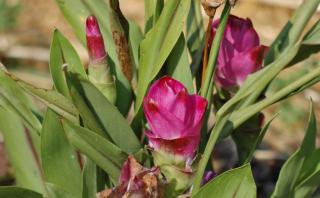

Turmeric (Curcuma longa) is a perennial plant native to Southern Asia, known since Antiquity. It is a main ingredient for most types of currys.
Its rhizome, as oranges as a carrot, lends not only its color to the dish but also greatly enhances its health benefits and therapeutic value.
Indian and Chinese pharmacopeia have used turmeric for millennia, and Western doctors have been using it since the XIXth century to stimulate the liver, excite digestive and diuretic functions, treat jaundice, urinary disorders and joint inflammations. Today, turmeric demonstrates many more benefits.
 Turmeric loves part sun and revels in rich, cool, humus-rich, fibrous and well drained soil.
Turmeric loves part sun and revels in rich, cool, humus-rich, fibrous and well drained soil.
You can easily grow it as an indoor plant (it won’t survive the winter cold) in a pot that is about 12 inches (30 cm) wide. Water it regularly for the soil to stay moist.
6 to 10 months later, you’ll be collecting your first harvest!
Watch out because the inside of the turmeric root will stain everything if you aren’t careful. Table cloths, clothes and other fabrics will take on a yellow hue! This coloring is virtually impossible to clean off.
Turmeric is involved in many culinary recipes, and is part of most curry preparations.
It can be used in soup and salad dressings, and with meat, eggs and vegetables.